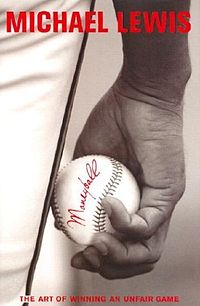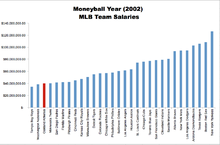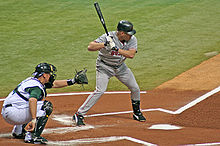- Moneyball
-
- For the film based on the book, see Moneyball (film). For the statistical approach sometimes referred to as "Moneyball", see Sabermetrics.
Moneyball: The Art of Winning an Unfair Game 
Author(s) Michael Lewis Country United States Language English Publisher W.W. Norton & Company Inc. Publication date 2003 Media type Print (Hardcover) Pages 288 ISBN ISBN 0-393-05765-8 OCLC Number 51817522 Dewey Decimal 796.357/06/91 LC Classification GV880 .L49 2003 Moneyball: The Art of Winning an Unfair Game (ISBN 0-393-05765-8) is a book by Michael Lewis, published in 2003, about the Oakland Athletics baseball team and its general manager Billy Beane. Its focus is the team's modernized, analytical, sabermetric approach to assembling a competitive baseball team, despite Oakland's disadvantaged revenue situation. A film based on the book starring Brad Pitt was released in 2011.
Contents
Synopsis
The central premise of Moneyball is that the collected wisdom of baseball insiders (including players, managers, coaches, scouts, and the front office) over the past century is subjective and often flawed. Statistics such as stolen bases, runs batted in, and batting average, typically used to gauge players, are relics of a 19th century view of the game and the statistics that were available at the time. The book argues that the Oakland A's' front office took advantage of more empirical gauges of player performance to field a team that could compete successfully against richer competitors in Major League Baseball.
Rigorous statistical analysis had demonstrated that on-base percentage and slugging percentage are better indicators of offensive success, and the A's became convinced that these qualities were cheaper to obtain on the open market than more historically valued qualities such as speed and contact. These observations often flew in the face of conventional baseball wisdom and the beliefs of many baseball scouts and executives.
By re-evaluating the strategies that produce wins on the field, the 2002 Athletics, with approximately $41 million in salary, were competitive with larger market teams such as the New York Yankees, who spent over $125 million in payroll that same season. Because of the team's smaller revenues, Oakland is forced to find players undervalued by the market, and their system for finding value in undervalued players has proven itself thus far.
Several themes Lewis explored in the book include: insiders vs. outsiders (established traditionalists vs. upstart proponents of sabermetrics), the democratization of information causing a flattening of hierarchies, and the ruthless drive for efficiency that capitalism demands. The book also touches on Oakland's underlying economic need to stay ahead of the curve; as other teams begin mirroring Beane's strategies to evaluate offensive talent, diminishing the Athletics' advantage, Oakland begins looking for other undervalued baseball skills such as defensive capabilities.
Moneyball also touches on the A's methods of prospect selection. Sabermetricians argue that a college baseball player's chance of MLB success is much higher than a traditional high school draft pick. Beane maintains that high draft picks spent on high school prospects, regardless of talent or physical potential as evaluated by traditional scouting, are riskier than if they were spent on more polished college players. Lewis cites A's minor leaguer Jeremy Bonderman, drafted out of high school in 2001 over Beane's objections, as but one example of precisely the type of draft pick Beane would avoid. Bonderman had all of the traditional "tools" that scouts look for, but thousands of such players have been signed by MLB organizations out of high school over the years and failed to develop. Lewis explores the A's approach to the 2002 MLB Draft, when the team had a nearly unprecedented run of early picks. The book documents Beane's often-tense discussions with his scouting staff (who favored traditional subjective evaluation of potential rather than objective sabermetrics) in preparation for the draft to the actual draft, which defied all expectations and was considered at the time a wildly successful (if unorthodox) effort by Beane.
In addition, Moneyball traces the history of the sabermetric movement back to such people as Bill James (now a member of the Boston Red Sox front office) and Craig R. Wright. Lewis explores how James' seminal Baseball Abstract, an annual publication that was published from the late-1970s through the late-1980s, influenced many of the young, up-and-coming baseball minds that are now joining the ranks of baseball management.
Impact
Moneyball has made such an impact in professional baseball that the term itself has entered the lexicon of baseball. Teams which appear to value the concepts of sabermetrics are often said to be playing "Moneyball". Baseball traditionalists, in particular some scouts and media members, decry the sabermetric revolution and have disparaged Moneyball for emphasizing concepts of sabermetrics over more traditional methods of player evaluation. Nevertheless, the impact of Moneyball upon major league front offices is undeniable. In its wake, teams such as the New York Mets, New York Yankees, San Diego Padres, St. Louis Cardinals, Boston Red Sox, Washington Nationals, Arizona Diamondbacks, Cleveland Indians,[1] and the Toronto Blue Jays have hired full-time sabermetric analysts. Since the book's publication and success, Lewis has discussed plans for a sequel to Moneyball called Underdogs, revisiting the players and their relative success several years into their careers. When the New York Mets hired Sandy Alderson – Beane's predecessor and mentor with the A's – as their general manager after the 2010 season, and hired Beane's former associates Paul DePodesta and J.P. Ricciardi to the front office, the team became known as the "Moneyball Mets".[2] Michael Lewis has acknowledged that the book's success may have negatively affected the Athletics' fortunes as other teams have accepted the use of sabermetrics, reducing the edge that Oakland received from using sabermetric-based evaluations.[3]
People discussed in the book
Moneyball also covers the lives and careers of several baseball personalities. The central one is Billy Beane himself, whose failed playing career is contrasted with wildly optimistic predictions by scouts.
Players and people discussed in Moneyball:
Oakland farm system
 Nick Swisher, the prospect the traditional scouts and statisticians agreed upon.
Nick Swisher, the prospect the traditional scouts and statisticians agreed upon.
- Barry Zito – 2002 AL Cy Young winner, part of the "Big 3" with Mulder and Hudson (below)
- Mark Mulder – part of the "Big 3" with Zito and Hudson
- Tim Hudson – part of the "Big 3" with Mulder and Zito
- Kirk Saarloos
- John Baker
- Joe Blanton
- Jason Giambi – 2000 AL MVP, signed with the New York Yankees in 2002 for $120 million over 7 years
- Miguel Tejada – 2002 AL MVP
- Eric Chavez – six-time AL Gold Glove winner
- Jeremy Brown
- Nick Swisher
- Bobby Crosby
- Mark Teahen
- Jeremy Bonderman – traded to the Detroit Tigers in 2002
Oakland bullpen
- Jason Isringhausen – signed with the St. Louis Cardinals in the 2001-02 offseason
- Billy Koch – 2002 AL Relief Pitcher of the Year
- Chad Bradford
- Jim Mecir
- Ricardo Rincón
- Mike Magnante
Other players
- Kevin Youkilis
- Prince Fielder – son of former slugger Cecil Fielder, drafted in 2002 year by the Milwaukee Brewers. Claimed by Beane to be "too fat" even for the A's.
- B. J. Upton - cited as an example of "bad high school" draft pick.
- Scott Kazmir - cited as an example of teams' – in this case the New York Mets – foolishness in drafting high school pitchers because of the difficulty in projecting their future, as opposed to college players.
- Jamie Moyer – then with the Seattle Mariners
- Terrence Long
- Erik Hiljus
- David Justice
- Jeremy Giambi
- Alex Rodriguez – Beane compares A-Rod's stats to those of Eric Chavez.
- Greg Maddux
- Cliff Floyd
- Alfonso Soriano
- Jeff Francis
- Zack Greinke – Drafted by the Kansas City Royals in 2002
- Scott Hatteberg
- Scouts, management, and journalists
- Billy Beane
- Paul DePodesta – Assistant GM
- Grady Fuson - Head of scouting
- Ron "Hoppy" Hopkins - National cross-checker scout
- J. P. Ricciardi – worked under Beane and DePodesta as Director of Player Personnel.
- Sandy Alderson - Beane's predecessor and mentor with the Athletics
- Peter Gammons – Sportswriter
- Art Howe – Oakland field manager
- Ron Washington - Athletics coach
- Joe Morgan – Hall of Fame second baseman and ESPN broadcaster
- Steve Phillips - New York Mets GM
- Bill James - baseball writer and statistician whose Baseball Abstract books greatly influenced Beane
- Omar Minaya - Montreal Expos GM
Analysis of the 2002 Major League Baseball draft
Beane's list
Beane put together a list of twenty players they’d draft in a "perfect world", meaning if money was no object and they didn't have to compete with the other twenty-nine teams.
The list, and the teams who drafted them:
- Pitchers
- Jeremy Guthrie - Cleveland, #22 (1st round)
- Joe Blanton - Oakland, #24 (1st round)
- Jeff Francis - Colorado, #9 (1st round)
- Luke Hagerty - Chicago Cubs, #32 (1st round)
- Ben Fritz - Oakland, #30 (1st round)
- Robert Brownlie - Chicago Cubs, #21 (1st round)
- Stephen Obenchain - Oakland, #37 (1st round)
- Bill Murphy - Oakland, #98 (3rd round)
- Hitters
- Nick Swisher - Oakland, #18 (1st round)
- Russ Adams - Toronto, #14 (1st round)
- Khalil Greene - San Diego, #13 (1st round)
- John McCurdy - Oakland, #26 (1st round)
- Mark Teahen - Oakland, #39 (1st round)
- Jeremy Brown - Oakland, #35 (1st round)
- Steve Stanley - Oakland, #67 (2nd round)
- John Baker - Oakland, #128 (4th round)
- Mark Kiger - Oakland, #158 (5th round)
- Brian Stavisky - Oakland, #188 (6th round)
- Shaun Larkin - Cleveland, #274 (9th round)
- Brant Colamarino - Oakland, #218 (7th round)
Oakland's picks
- #18 - Nick Swisher - successful major leaguer, traded to Chicago White Sox after 2007, traded to New York Yankees after 2008
- #24 - Joe Blanton - successful major leaguer, traded to Philadelphia Phillies
- #26 - John McCurdy - out of professional baseball since 2006
- #30 - Ben Fritz - had Tommy John surgery, currently in minor leagues
- #35 - Jeremy Brown - has had small stints of time in the majors, retired prior to the 2008 season.
- #37 - Stephen Obenchain - retired after a lack of success at the A and AA levels
- #39 - Mark Teahen - successful major leaguer, traded to the Kansas City Royals and is currently with the Toronto Blue Jays
- #67 - Steve Stanley - topped out in AAA for the A's
- #98 - Bill Murphy - traded three times and debuted with the Arizona Diamondbacks in 2007
- #128 - John Baker - traded to the Florida Marlins and debuted and became the starting catcher in 2008.
- #158 - Mark Kiger - traded several times, now with the AA affiliate of the New York Mets (Binghamton Mets)
- #188 - Brian Stavisky - currently with the AA affiliate of the Philadelphia Phillies
- #218 - Brant Colamarino - currently with the AA affiliate of the A's
Film
Main article: Moneyball (film)A movie based on the book was released in 2011. Actor Brad Pitt stars as Billy Beane, while Jonah Hill plays a fictional character based on Paul DePodesta; Phillip Seymour Hoffman plays A's manager, Art Howe. Academy Award-winning screenwriter Steve Zaillian was hired to write the script, and Steven Soderbergh was slated to direct, replacing David Frankel.[4] "I want you to not realize how much information is being thrown at you," said Soderbergh, when asked how he was going to make an entertaining film based on statistics. "We've found a couple of ideas on how to bust the form a bit, in order for all that information to reach you in a way that's a little oblique."[5] Scott Hatteberg and David Justice were slated to play themselves in the movie.[6]
However, on June 22, 2009, because of conflicts over a revised script by director Soderbergh, Sony put the movie on hold just days before it was scheduled to begin shooting.[7] Soderbergh's script called for interviews of real-life players and other methods untraditional to sports movies. As a result, Soderbergh was let go.
Bennett Miller took over directing duties,[8] and Aaron Sorkin rewrote the script.[8] Shooting began on July, 2010 at Blair Field, the Sports Stadium for Wilson High School (Long Beach, California), Sony Studios in Culver City, Dodger Stadium, and the Oakland-Alameda Coliseum.[9][10] The film was released in theaters September 23rd, 2011.
In popular culture
The book is parodied in the Simpsons episode "MoneyBART", in which Lisa manages Bart's Little League baseball team using sabermetric principles. Bill James made an appearance in this episode.
References
- Notes
- ^ Woolner, Keith (2007-05-04). "Articles | Aim For The Head: Aim For the Front Office". Baseball Prospectus. http://www.baseballprospectus.com/article.php?articleid=6187. Retrieved 2011-09-24.
- ^ "The Moneyball Mets". New York (magazine). 25 March 2011. http://nymag.com/news/sports/games/sandy-alderson-2011-4/. Retrieved 2011-04-06.
- ^ "Michael Lewis on A's 'Moneyball' legacy". San Francisco Chronicle. 18 September 2011. http://www.sfgate.com/cgi-bin/article.cgi?f=/c/a/2011/09/18/SP3J1L571K.DTL&ao=all. Retrieved 2011-09-23.
- ^ Siegel, Tatiana. "Columbia pitches Moneyball to Pitt," Variety (October 16, 2008).
- ^ "Steven Soderbergh: The Girlfriend Experience". SuicideGirls.com. 21 May 2009. http://suicidegirls.com/interviews/Steven%20Soderbergh%3A%20The%20Girlfriend%20Experience/. Retrieved 2009-05-21.
- ^ Stiglich, Joe. "A's notebook: Lights, camera, action ... for Moneyball," InsideBayArea.com (May 26, 2009).
- ^ ""Benched: 'Moneyball' Flick on Hold at Last Minute," Associated Press (June 22, 2009)". Sports.espn.go.com. 2009-06-22. http://sports.espn.go.com/mlb/news/story?id=4278999. Retrieved 2011-09-24.
- ^ a b Fleming, Mike. ""Finally, It's Batter Up For 'Moneyball,'" Deadline.com (April 12, 2010)". Deadline.com. http://www.deadline.com/2010/04/finally-its-batter-up-for-moneyball/. Retrieved 2011-09-24.
- ^ ""'Moneyball' begins filming in Oakland," ABC7 KGO-TV San Francisco, CA (July 27, 2010)". Abclocal.go.com. 2010-07-27. http://abclocal.go.com/kgo/story?section=news/entertainment&id=7575771. Retrieved 2011-09-24.
- ^ September 14, 2010 (2010-09-14). ""'Moneyball' films scenes in Dodger Stadium," Los Angeles Times (September 14, 2010)". Latimesblogs.latimes.com. http://latimesblogs.latimes.com/entertainmentnewsbuzz/2010/09/moneyball-films-scenes-in-dodger-stadium.html. Retrieved 2011-09-24.
External links
- Majoring In Moneyball by John Manuel
- In Defense of Moneyball and Sabermetrics
- Billy Beane's Perfect Draft: A Baseball Revolution? by Richard van Zandt - guest column at BaseballEvolution.com (April 13, 2006)
Works of Michael Lewis Books Liar's Poker (1989) • Pacific Rift (1991) • The Money Culture (1991) • Trail Fever (1997) • The New New Thing (2000) • Next: The Future Just Happened (2001) • Moneyball (2003) • Coach: Lessons on the Game of Life (2005) • The Blind Side (2006) • The Real Price of Everything (2008) • Panic: The Story of Modern Financial Insanity (2008) • Home Game (2009) • The Big Short (2010) • Boomerang: Travels in the New Third World (2011)Adaptations The Blind Side (film) • Moneyball (film)Categories:- 2003 books
- Major League Baseball books
- Books by Michael Lewis
- Oakland Athletics
- Books adapted into films
Wikimedia Foundation. 2010.


